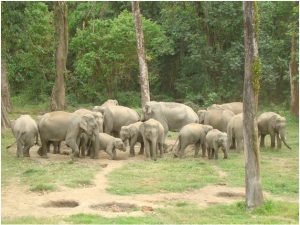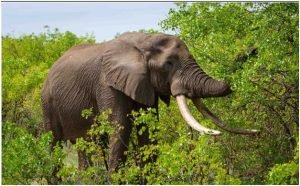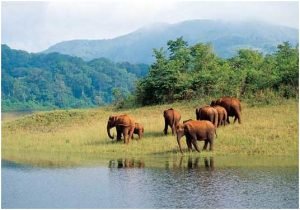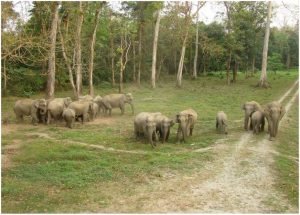(Help sincerely in efforts to conserve and protect elephants from the numerous threats they face worldwide.)
BY DR. RAVINDER PALL SAINI
INDIAN FOREST SERVICE ( RETIRED)
MEMBER, BOARD OF MANAGEMENT,
FOREST RESEARCH UNIVERSITY,
DEHRADUN.
DEHRADUN, 12 AUGUST 2023:
This Year’s Theme: “Safeguarding Elephant Habitats for a Sustainable Tomorrow”.
World Elephant Day, 12 August is a worldwide celebration pledged to stimulate perception about the significant issues faced by elephants and promoting their protection and conservation. This day serves as a manifesto to emphasize the challenges elephants encounter, including habitat loss, poaching for ivory, human-elephant conflicts, and the need for better conservation efforts. This instance aims to advance the importance of protecting these wonderful creatures for future generations and to encourage actions that contribute to their benefits and survival. It’s a day to appreciate the vital role elephants play in sustaining ecosystems, as well as to support organizations and initiatives that work towards their conservation.
“We admire elephants in part because they demonstrate what we consider the finest human traits: empathy, self-awareness, and social intelligence. But the way we treat them puts on display the very worst of human behaviour.” —– Graydon Carter, Editor of Vanity Fair.

World Elephant Day significance:
The day is marked every year to create awareness about the wild beast so that their illegal hunting and poaching can be curtailed and completely banned. The world elephant society was founded in November 2015 to initiate fervent support to this cause and create mass awareness for an effective elephant conservation worldwide.
World Elephant Day is a podium for groups and individuals to come together and speak out about problems that are being faced for conservation of elephants’ world over. Its unbiased approach visualization that enables and supports all organizations and individuals to organize campaigns under the World Elephant Day banner, enabling everyone to work together to address this crucial global issue that necessitates collaboration across national boundaries and political divides. This powerful, cooperative global opinion offers individuals, decision-makers, legislators, and governments resources to develop and support conservation resolutions that will make the world a safe place for elephants, animals, and habitats for future generations to appreciate.

Organizers of World Elephant Day:
World Elephant Day is an international initiative co-founded by the Elephant Reintroduction Foundation and Patrica Sims, founder of the world elephant society which is a charitable organization that helps to spread awareness about the conservation of elephants around the world.
Initiation of Elephant Day Worldwide:
The first international Elephant Day was celebrated on 12th August 2012 and thereafter this day is dedicated to the cause of elephant conservation and their protection. This day makes us know and generates a mass awareness that people shoulder the responsibility to protect the elephants by curtailing the illegal hunting, poaching, and trading of tusks and develop better treatment facilities for the captive elephants.
Ecological Importance of Elephants:
Elephants play a crucial role as ecosystem engineers, maintaining mineral-rich clearings in the forest, on which many other species depend on, and providing a way for important soil nutrients to be spread around at a continental scale. As seed dispersers, they also help maintain the largest tree species, which happen to be the most important for carbon sequestration.
Facts about Elephants:
They are the world’s largest land animals. The African Savanna (Bush) elephant is the world's largest land animal – with adult males, or bull elephants, standing up to 3m high and weighing up to 6,000kg on average. Males only reach their full size at 35-40 years – that’s well over half their lifespan as wild elephants can live for up to 60-70 years. And it’s not just the adults – even calves are huge! At birth, a baby elephant can weigh 120kg.
There are three species of elephant:
African Savanna (Bush), African Forest and Asian.
The ears of African elephants are much larger than their cousins and are described as being shaped like the African continent, whereas the ears of Asian elephants are shaped like the Indian subcontinent. There’s also a trunk difference – African elephants have two ‘fingers’ at the tip of their trunks, whereas Asian elephants have one.

Elephants’ trunks are so strong and have around 150,000 muscle units in their trunk.
Their trunks are perhaps the most sensitive organ found in any mammal. Elephants use their trunks to suck up water to drink – it can contain up to 8 liters of water. They also use their trunks as a snorkel when swimming.
Their tusks are their teeth. Elephant tusks are enlarged incisor teeth which first appear when elephants are around 2 years old. Tusks continue growing throughout their lives.

Tusks are used to help with feeding – prizing bark off trees or digging up roots – or as a defense when fighting. But these beautiful tusks often cause elephants danger. They’re made from ivory, a much-desired object.
An elephant’s skin is 2.5cm thick in most places. The folds and wrinkles in their skin can retain up to 10 times more water than flat skin does, which helps to cool them down. They keep their skin clean and protect themselves from sunburn by taking regular dust and mud baths.

Elephants eat grasses, leaves, shrubs, fruits, and roots depending on the season and their habitat. When it’s particularly dry, elephants will eat more woody parts of trees and shrubs like twigs, branches, and barks. They need to eat up to 150kg of food per day.

Elephants eat so much that they can spend up to three-quarters of their day just eating.
Elephants communicate in a variety of ways – including sounds like trumpet calls (some sounds are too low for people to hear), body language, touch, and scent. They can also communicate through seismic signals – sounds that create vibrations in the ground – which they may detect through their bones.

The elephant’s temporal lobe (the area of the brain associated with memory) is larger and denser than that of people – hence the saying ‘elephants never forget’. Around 90% of African elephants have been wiped out in the past century – largely due to the ivory trade – leaving an estimated 415,000 wild elephants alive today. Asian elephants are also under threat, having declined by at least 50% in the last three generations. There are only around 48,000–52,000 individuals left in the wild. As their habitat changes, fragments and is lost to human settlements and agriculture, populations of Asian elephants are finding it harder to follow their traditional migration routes to reach water, feeding and breeding grounds, and they’re coming into often dangerous contact with people.
Dangers faced by the Elephants:
* Illegal hunting
* Friction arising by rising human-elephant conflicts.
* Mistreatment of elephants in captivity
* Poaching and killing for the lucrative ivory of tusks.
Strategy to combat the threats faced by the Elephants.
* Working together with NGOs and inhabitants around forests towards creating better protection for the elephants.
* Effectively improve the illegal poaching, hunting and trade.
*Give more training and modern equipment to foresters engaged in the protection and conservation of elephants.
*Conserve their natural habitats with well-planned management plans.
*Better monitoring of population trends world over.
* Develop initiatives at the global level to conserve Elephants more scientifically and incorporating effective use of GIS and MIS.
Conservation Efforts:
For the conservation of elephants, a program MIKE (Monitoring the Illegal Killing of Elephants) was established by the Convention on International Trade in Endangered Species of Wild Fauna and Flora (CITES). Around 28 sites participate in the Initiative MIKE in Asia and own fact, India has 10 sites that took part in the field exercises.

Elephant Conservation in India:
Elephant – The National Heritage Animal. The government of India in the year 2010 declared Elephant as the national heritage animal of the country on the recommendations of the standing committee of the national board for wildlife. This was done to make sure that sufficient protection for elephants was provided before their numbers fell to panic levels as in the case of tigers.
Through the Project Elephant scheme launched in 1992, the central government helps in the protection and management of elephants to the states having wild elephants in a free-ranging population.
It ensures the protection of elephant corridors and elephant habitat for the survival of the elephant population in the wild.
This elephant conservation strategy is mainly implemented in 16 of 28 states or union territories in the country which includes Arunachal Pradesh, Assam, Andhra Pradesh, Chhattisgarh Jharkhand, Kerala, Karnataka, Meghalaya, Maharashtra, Nagaland, Orissa, Tamil Nadu, Uttaranchal, Uttar Pradesh, and West Bengal.
The union government provides technical and financial help to these states to carry out and achieve the goals of project elephant. Not just that, assistance for the purpose of the census, training of field officials is also provided to ensure the mitigation and prevention of man-elephant conflict.
According to recent reports, the elephant population in India is demonstrating a stable trend across elephant reserves in India. The elephant population of India was 27,682 in 2007. The average population throughout the country is estimated to be between 29,000 to 36,000.
“Elephants can sense danger. They're able to detect an approaching tsunami or earthquake before it hits. Unfortunately, Jack did not have this talent. The day his life was turned completely upside down, he was caught unaware.” ——-Jennifer Richard Jacobson, Small as a Gajah India

Advertisement:



































Add Comment